This design for the renovation of the palace guard tract reveals the striking yet functional potential for an interplay of baroque and contemporary design languages. As utmost care and sensitivity must be used when handling existing buildings such as these and, accordingly, the façade has been changed only minimally. The brickwork of six arches has been replaced to create a generous glass entrance structure suited to the new purpose. This gesture emphasizes the striking arcades of the lobby, allows natural light to suffuse the interior, and opens the building towards the main entrance of Schönbrunn Palace. Reinforcing the existing roof structure of the single-story building section made it possible to fully remove all interior walls. The result is a broad and open column-free hall with enough space to receive and distribute the flow of incoming visitors. Multi-functional furniture has been specially designed to meet the diverse use requirements, while still paying respect to the historic architecture of the rooms. A continuous wooden structure is mounted directly on the floor, and can be removed without affecting the original structure, thus assuring maximum reversibility. Most of the building’s functions are integrated into the compact form: cashiers, shop, café, bar, offices, kitchen, restrooms, and wiring. Additionally, movable partitions make it possible to create different spatial scenarios and to subdivide the hall into quiet waiting areas and administrative offices.
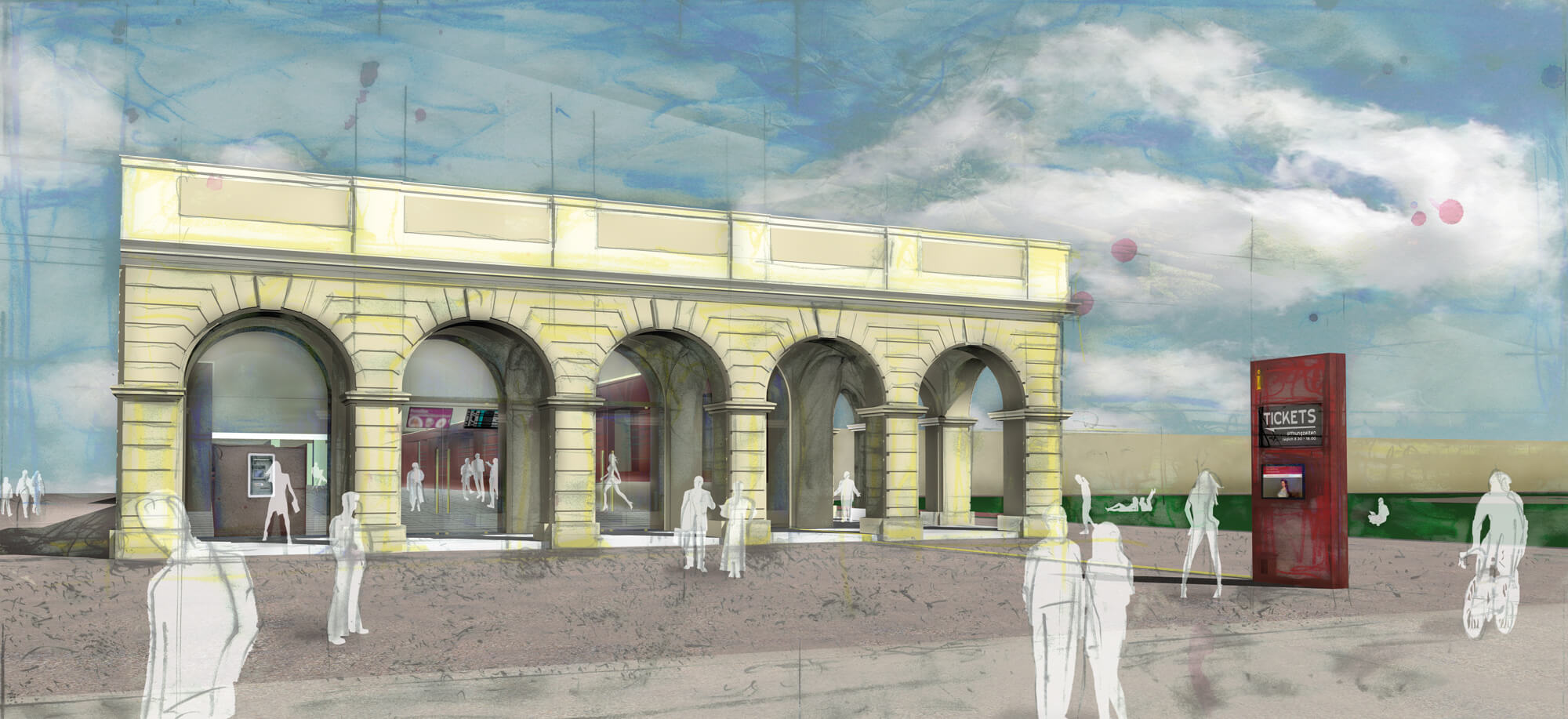
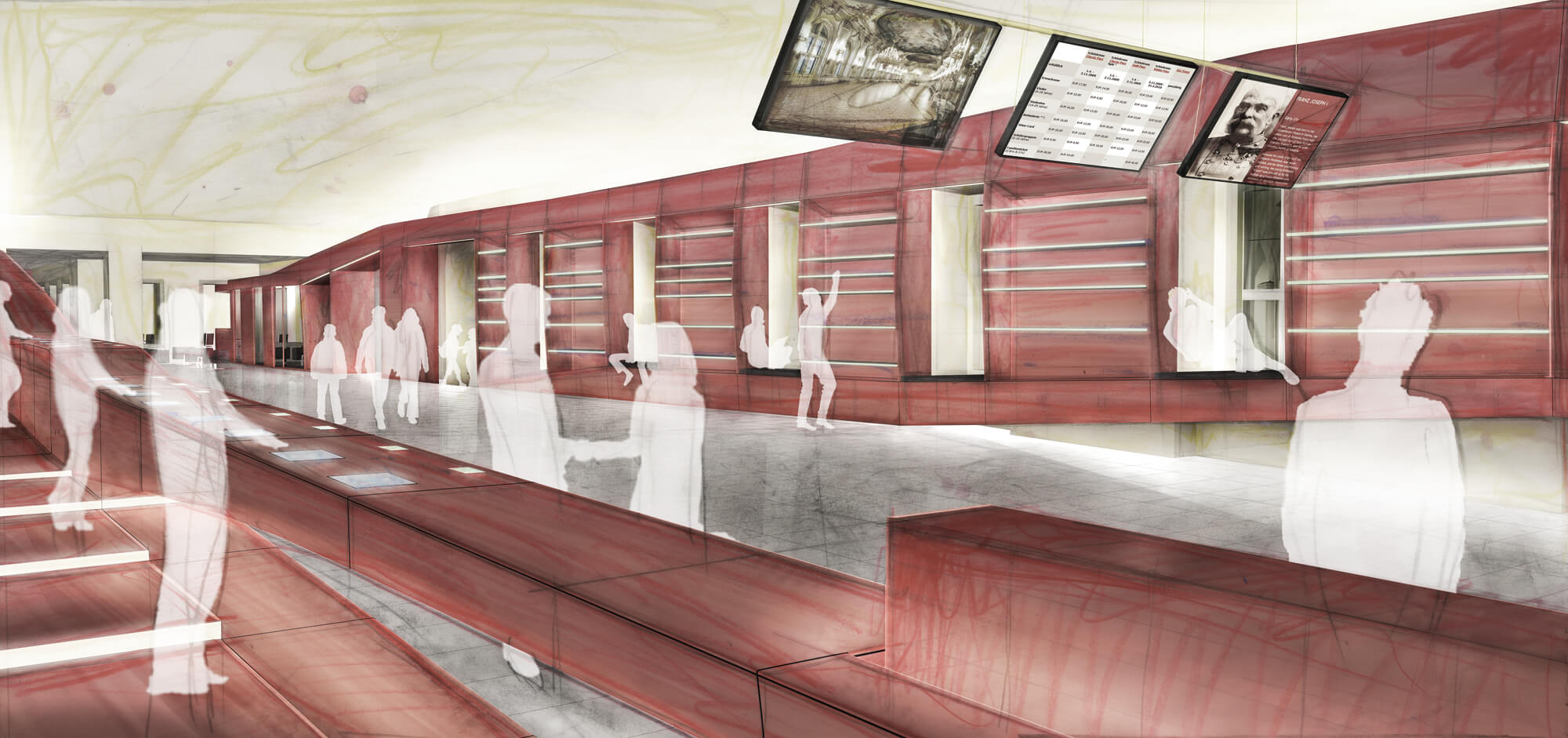
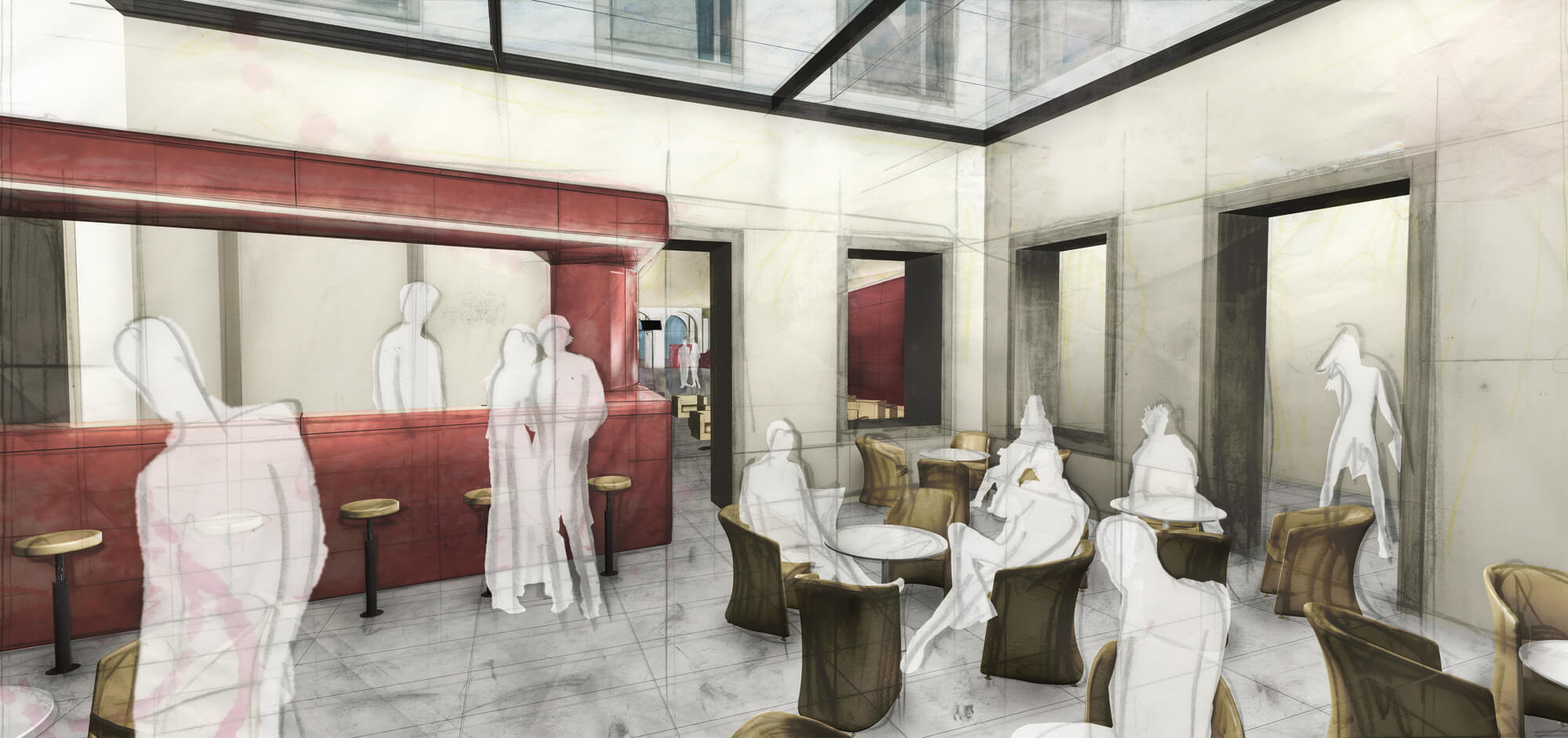
Location: 1130 Wien
Year: Wettbewerb 2009
Use Area: 1000m²
Team: Lukas Göbl, Oliver Ulrich
The parts of the St. Peter an der Sperr building complex — church, monastery, and municipal museum — are brought together to create a new unity. The result is a monolithic cube, which draws from the eaves height of the surrounding buildings and thus blends in, while still making a self-confident appearance on the cityscape. The new façade has a strong pixelated perforation that creates a diverse appearance and regulates insights, views, and lines of sight. The ground floor and first upper story façade is receded around the new main entrance area, creating a sheltered front area and marking the entrance. On the top floor, the façade surrounds an outdoor area, giving it a high-quality spatial closure and making the building seem to dissolve towards the sky at the prominent corner towards the Bürgermeistergarten. The heritage monastery and church, both museum extensions, are revitalized using minimally invasive measures. The new foyer, set along the exterior of the church nave, holds the box office area and a small shop with a cloakroom. The design of this building borrows from the new façade of the City Museum. The spatial concept fulfills the demands of a modern museum and makes linear exhibition tours and a multifunctional use of the rooms possible.
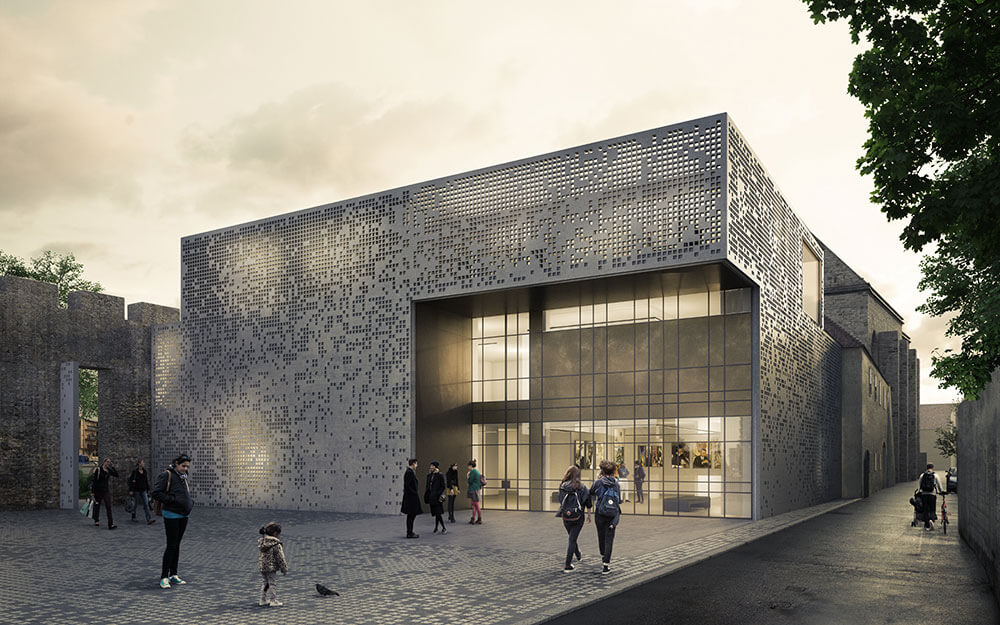
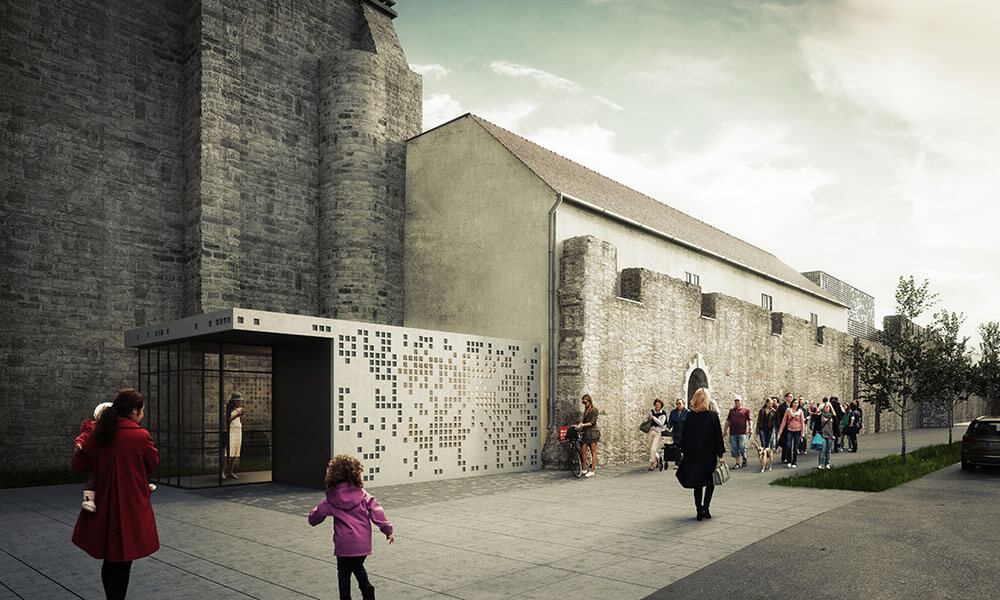
Location: St. Peter and der Sperr (Lower Austria)
Use Area: 1900 m²
Team: Lukas Göbl, Andrés España, Oliver Ulrich
in cooperation with architect Franz Gschwantner
The goal of the Lengenfeld Castle revitalization is to awaken the oeuvre of the Hauer-Fruhmann artist family to a new life. The refurbishment measures provide future events in the historic castle complex with a festive and honorable framework. The façade and some building sections will be restored as necessary, retroactive and ill-fitted installations and additions removed, and malplaced openings closed in order to revive the original harmonious appearance of the castle. The historic materials and surfaces will be carefully restored to their original state, making their history palpable and tangible. The shape and coloration of the new building sections contrasts with the existing sections, adding another “layer” to the historic fortress. A new courtyard roof using foil cushions — a “cumulus cloud” — is intentionally designed to have a hovering effect. The roofing provides protection from the elements while drawing the surrounding natural lighting into the courtyard, the climate of which is still an outdoor space. The exterior concept is based upon a painting by Johann Fruhmann. Blooming beds of flowers, seating areas, and meandering paths make his paintings come to life. The castle itself is freed from the surrounding embankments, thus allowing it to emerge in its original splendor. An intense landscape is proposed for north of the stream. A large lawn provides space for events and festivals. A filigree bridge leads across the stream to a naturally wild area.
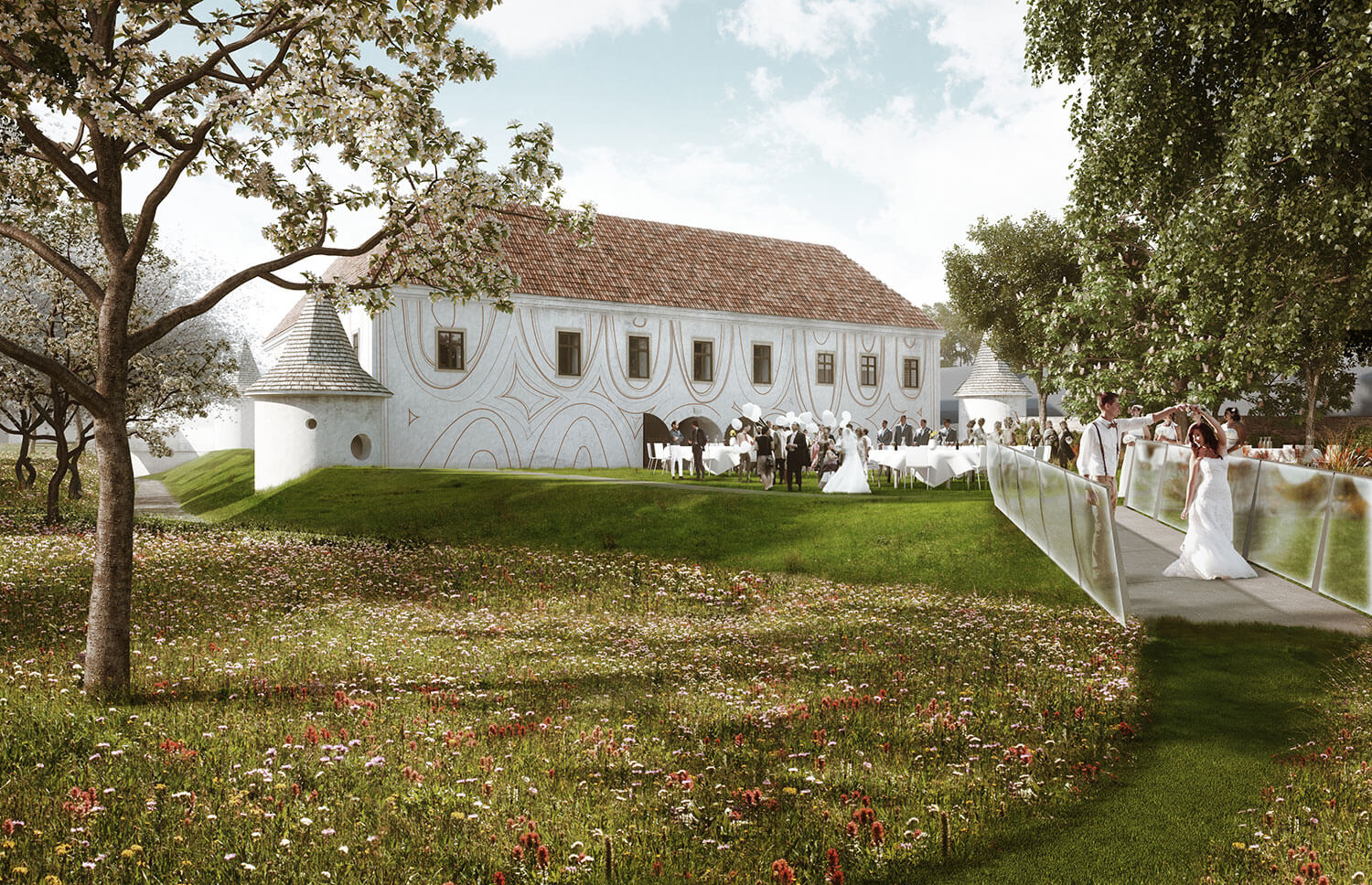
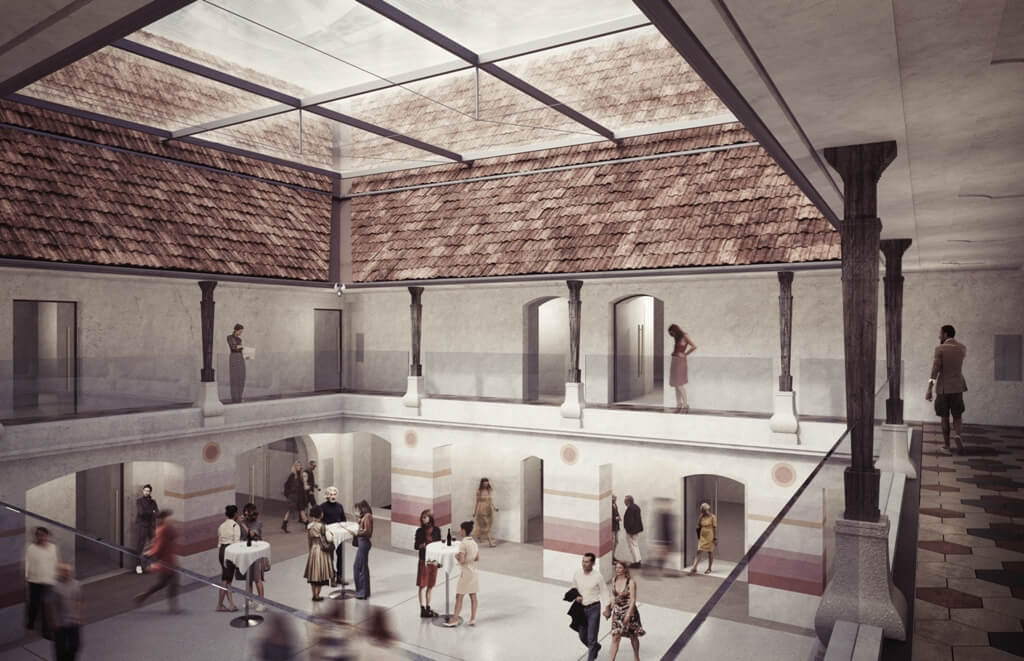
Location: Lengenfeld (Lower Austria)
Competition: 2nd place, 2015-2016
Use Area: 1000 m²
Team: Lukas Göbl, Oliver Ulrich, Jan Kovatsch, Andrés Espana in cooperation with Architekt Franz Gschwantner and grünplan gmbh
Architectural and environmental progress have been confidently united in this new building for the Wels Science Center. The progressive appearance of the new building, designed using passive energy technology, is indicative of its function as a showroom and education center for technological innovations. The area around the Science Center has been envisaged as an urban focal point, forming an attractive core. In order to facilitate navigation for visitors, the center’s interior is equipped with easily comprehended directional guides. An extensive ramp system and a central glass elevator distribute the flow of visitors throughout the facility. Visitors can explore the entire building, culminating with to the highest and final point: a second-floor terrace with a beautiful sweeping panorama of the city. In terms of interior design, the goal was to provide the greatest degree of flexibility for all types of exhibitions. For example, several different rooms on the ground floor may be connected into a single large space to accommodate large events. The intention of the design was to minimize the total surface area of the Science Center in order to maximize energy efficiency. Photovoltaic panels, solar thermal tube collectors, eco-panels, and “green panels” act as an energy supply. This “homemade” energy is stored in a massive concrete wall in the atrium. Aesthetic translucent thermal insulation is combined with double glazing and vacuum insulation to complete this intelligent building envelope.
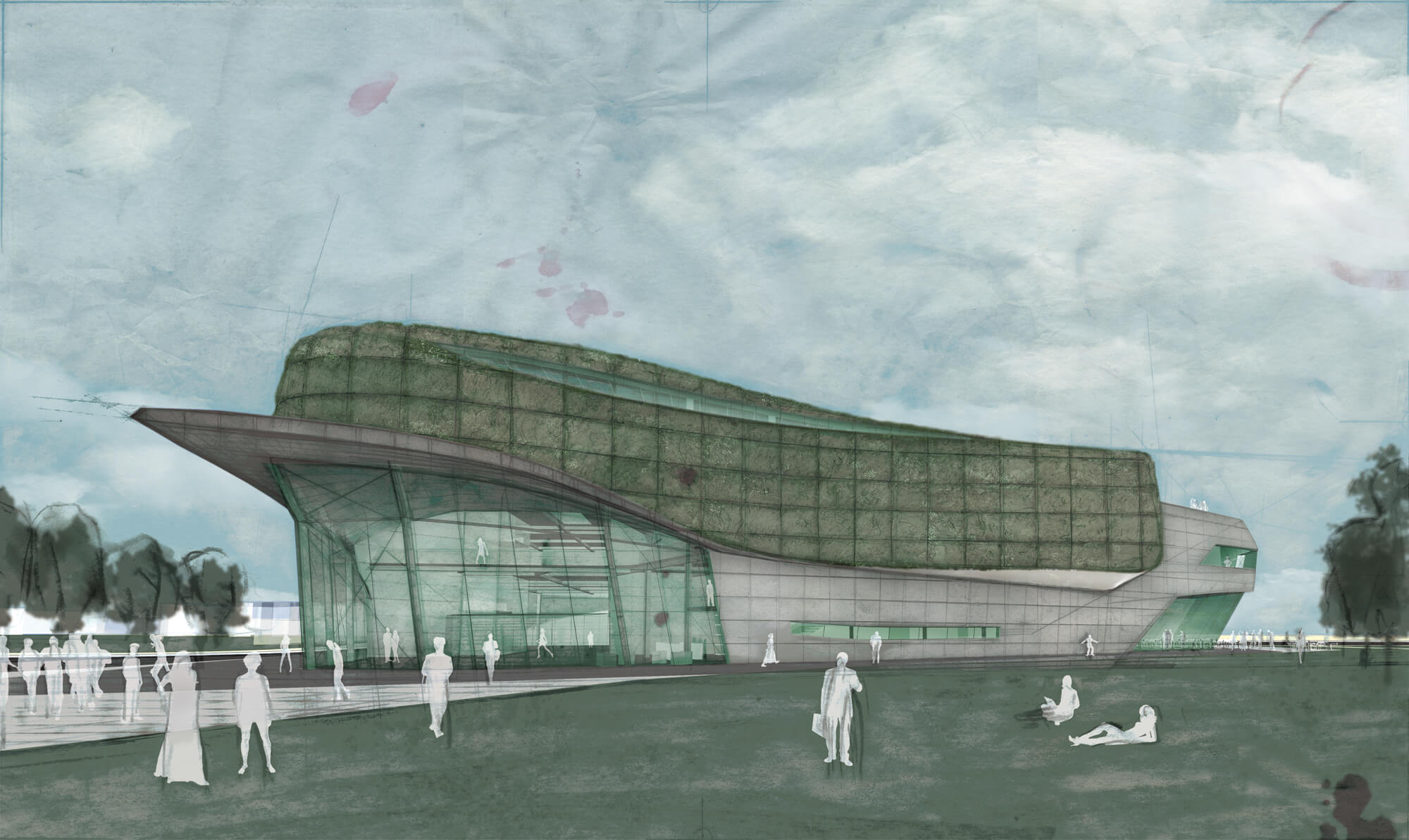
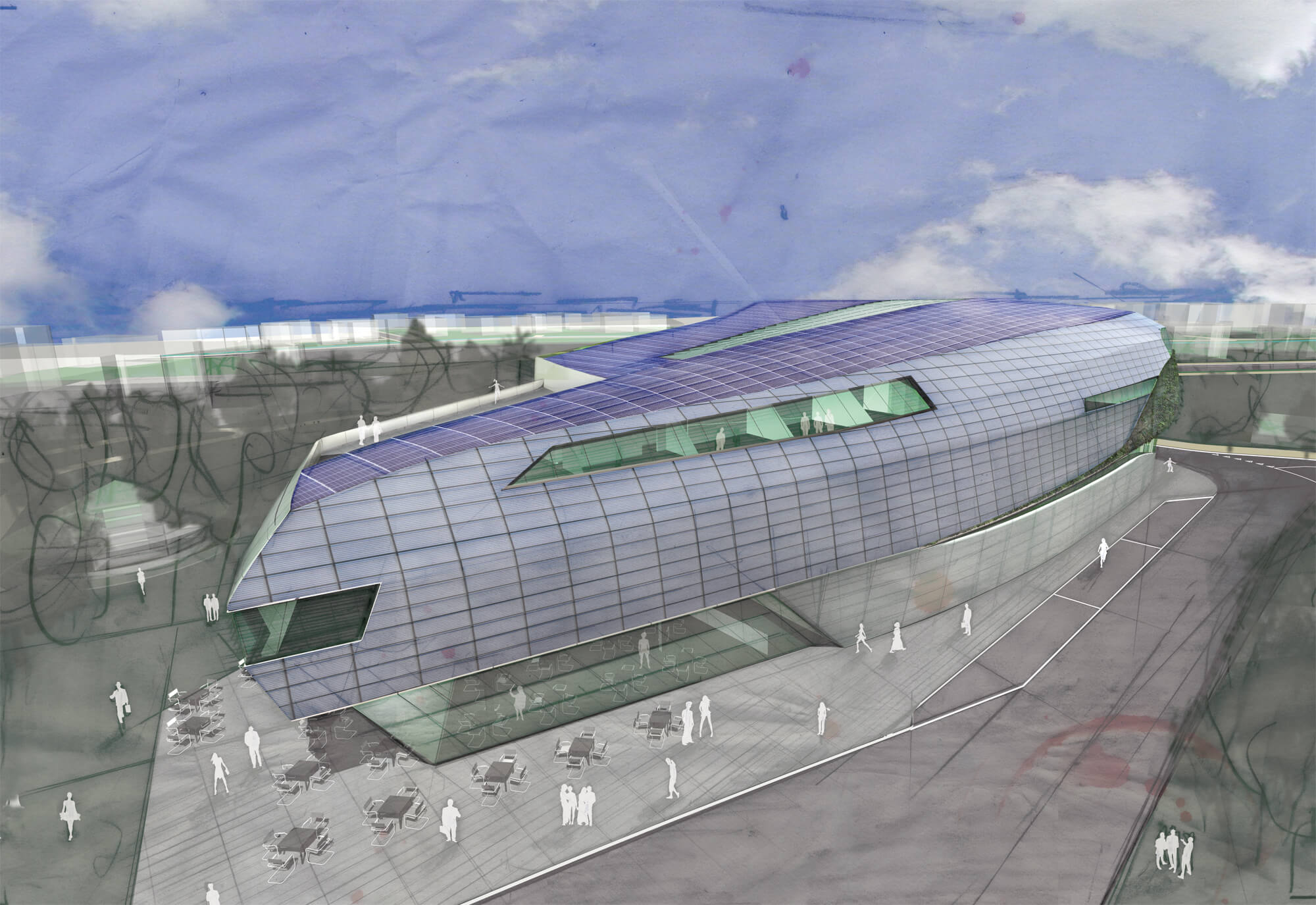
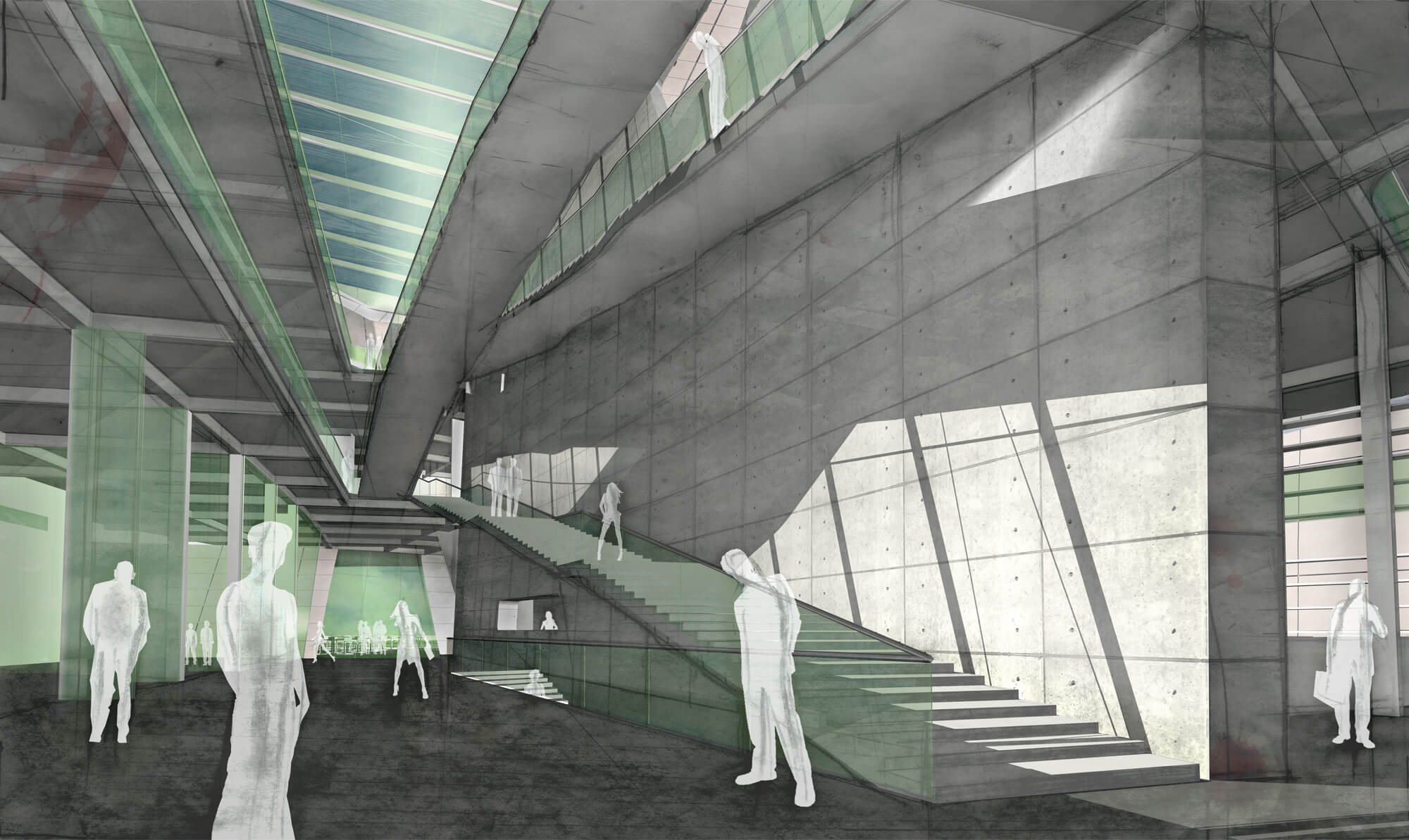
Location: Messeplatz 1, 4600 Wels (Upper Austria)
Year: Competition 2008
Use Area: 7000m²
Team: Lukas Göbl, Oliver Ulrich
The Maribor Art Gallery design competition presented the challenge of creating space for the interdisciplinary dialogue of various cultural institutions under one roof. The distinctive form of the Maribor Art Gallery combines functionality and efficiency, technology and architecture, education and knowledge, and creativity and presentation. The aim was to successfully integrate these different fields of interest to attain a mutually beneficial bundling of use options. The aesthetics of the building immediately set a new, striking symbol into the midst of Maribor’s urban landscape. The outer skin of the concrete and steel structure is made of white ceramic tiles. A network of black joints creates a grid pattern across the entire façade. The immediate surroundings become part of the building: Public walkways crisscross the entire property, even entering parts of the ground floor. The building can be entered from either side — from the river or coming from the public square to the north — guaranteeing that the Maribor Art Gallery is well integrated into the existing urban network of walkways. In addition, the architecture’s form reacts dynamically to topographical factors with a series of outcroppings and recesses. The interior layout harmonizes with the urban development concept: Public and semi-public spaces such as the entrance hall, cafe, restaurant, library, and reading room — each with a separate entrance — are located on the ground floor. The ticketing area and Information Centre of European Culture City 2012 are in the main hall. The Architecture Centre on the ground floor and the children’s museum on the first floor share a small, separate foyer. The western section of the building houses several offices and apartments. A central, shaft-like building structure connects the different exhibition spaces. In total, the exhibition area covers five levels, which are connected by a system of ramps, implying the dynamics of constant circulation – flows of knowledge, education, and visitors.
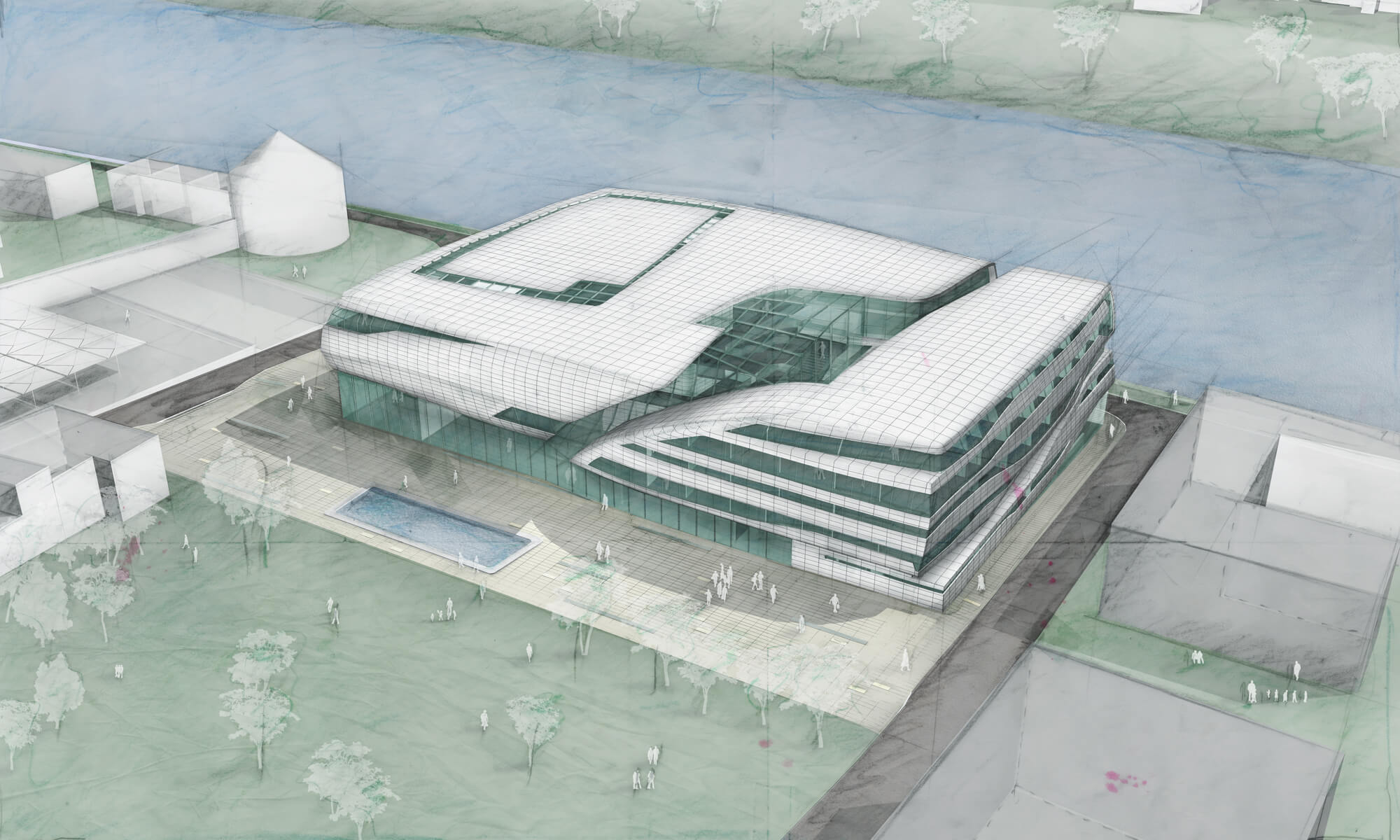
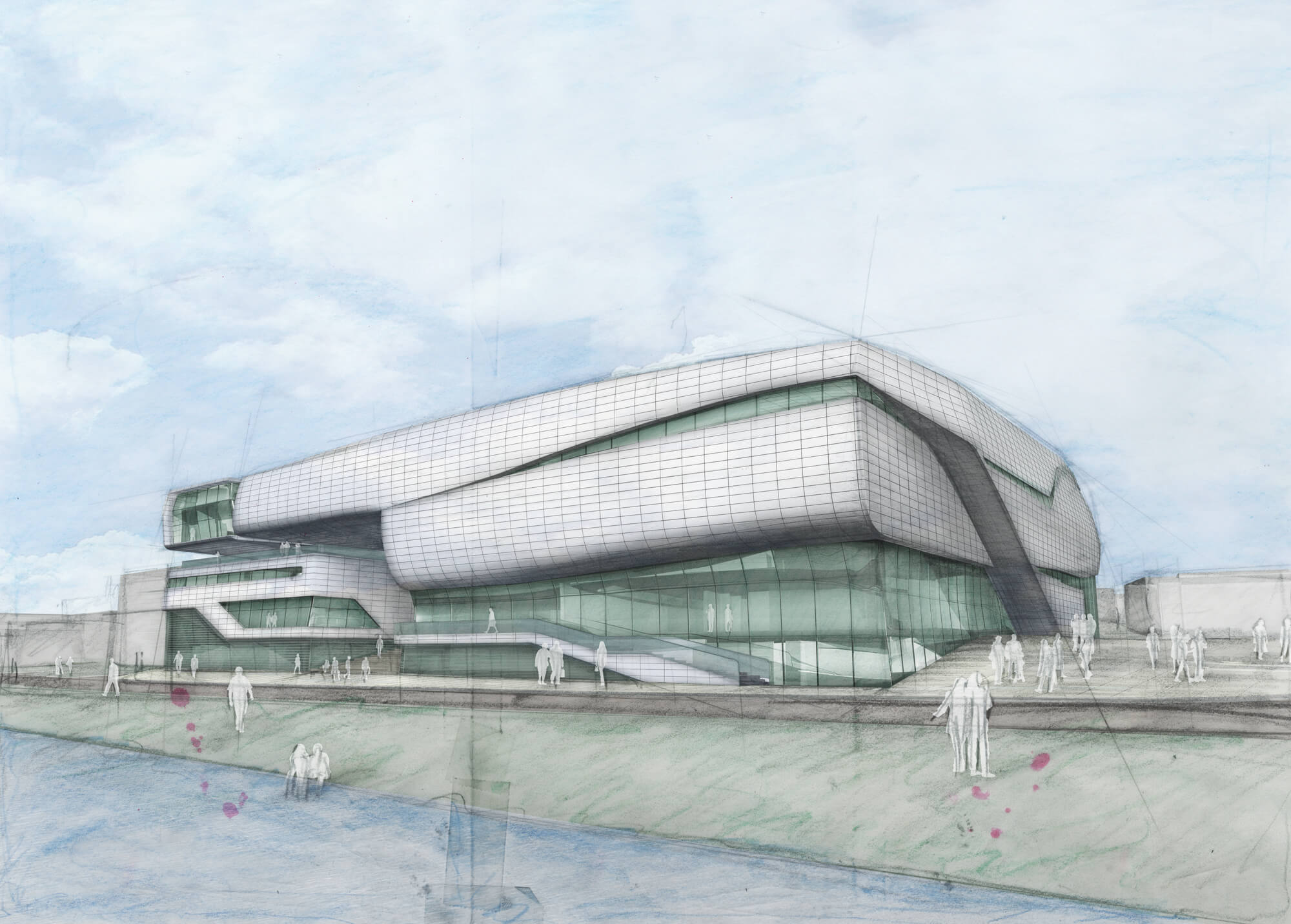
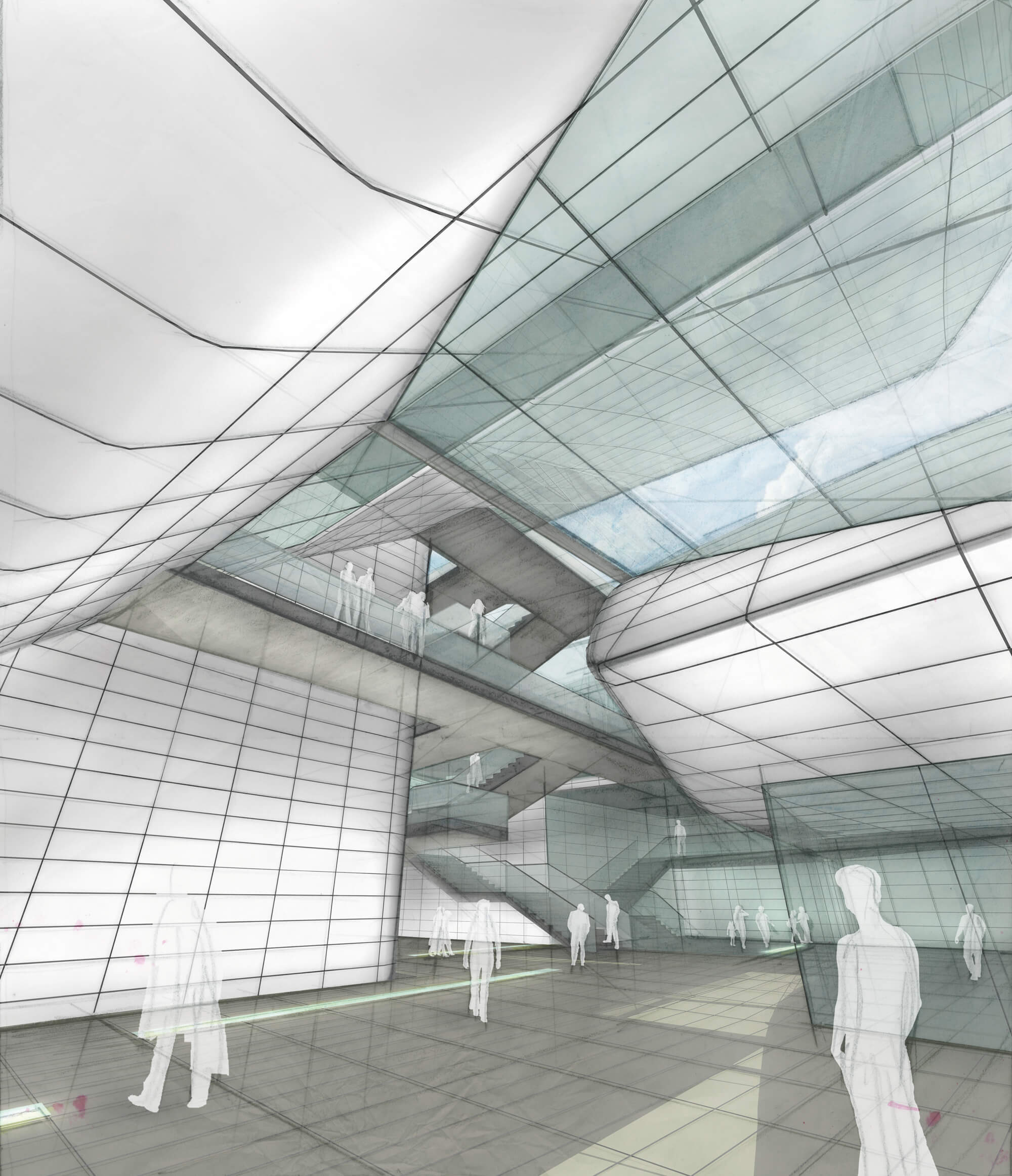
Location: Maribor (Slovenia)
Year: Competition 2010
Use Area 17 000m²
Design Team: Lukas Göbl, Oliver Ulrich
The new Citizen and Event Center in Böheimkirchen defines the region’s center, its contemporary design language and connection to public space imbuing the site with added quality. The building volumes are carefully situated and optimized to attain a three-part harmony together with the church that dominates the urban space: Multifunctional hall, administrative building, and church. Mount Kirchenberg, a topographically defining element of Böheimkirchen, is “continued” by the structure. The rear sections of the building are buried, the hill itself lushly covered in green. A public square precedes the building on two sides. This plaza provides space for an outside dining area and open-air events. A generously proportioned foyer joins the two main entrances. This creates a public path leading through the new building, making it an active part of the town by joining the main street and the park in a direct line. The project is designed as a reinforced steel structure. The floor slabs are equipped with a thermo-active building system for cooling and heating. In the ground floor area and some parts of the upper stories, a contemporary and functional façade construction made of a post-and-beam façade and structural glazing is used. However, the majority of the façade will be a curtain of fiberglass concrete.
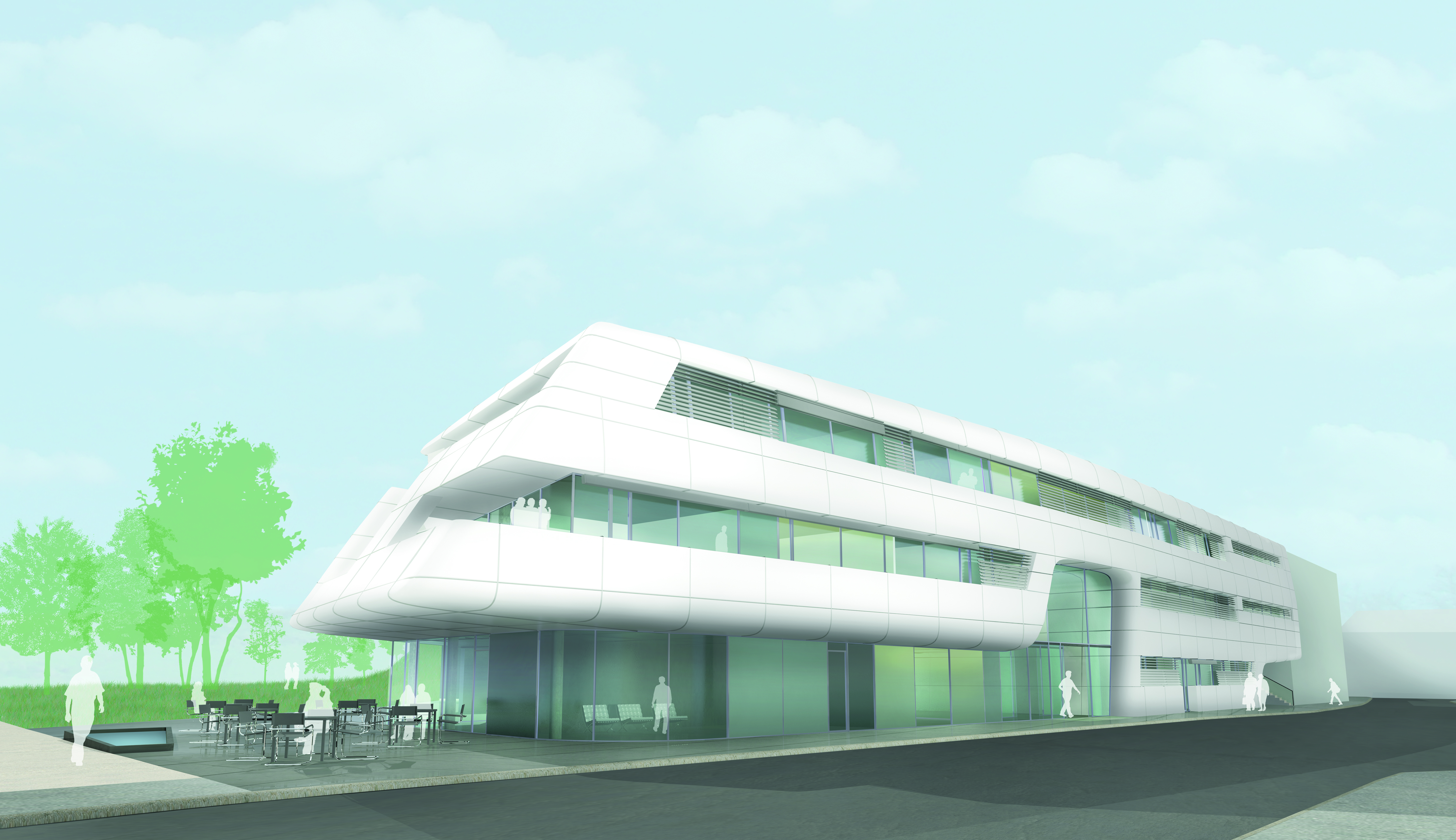
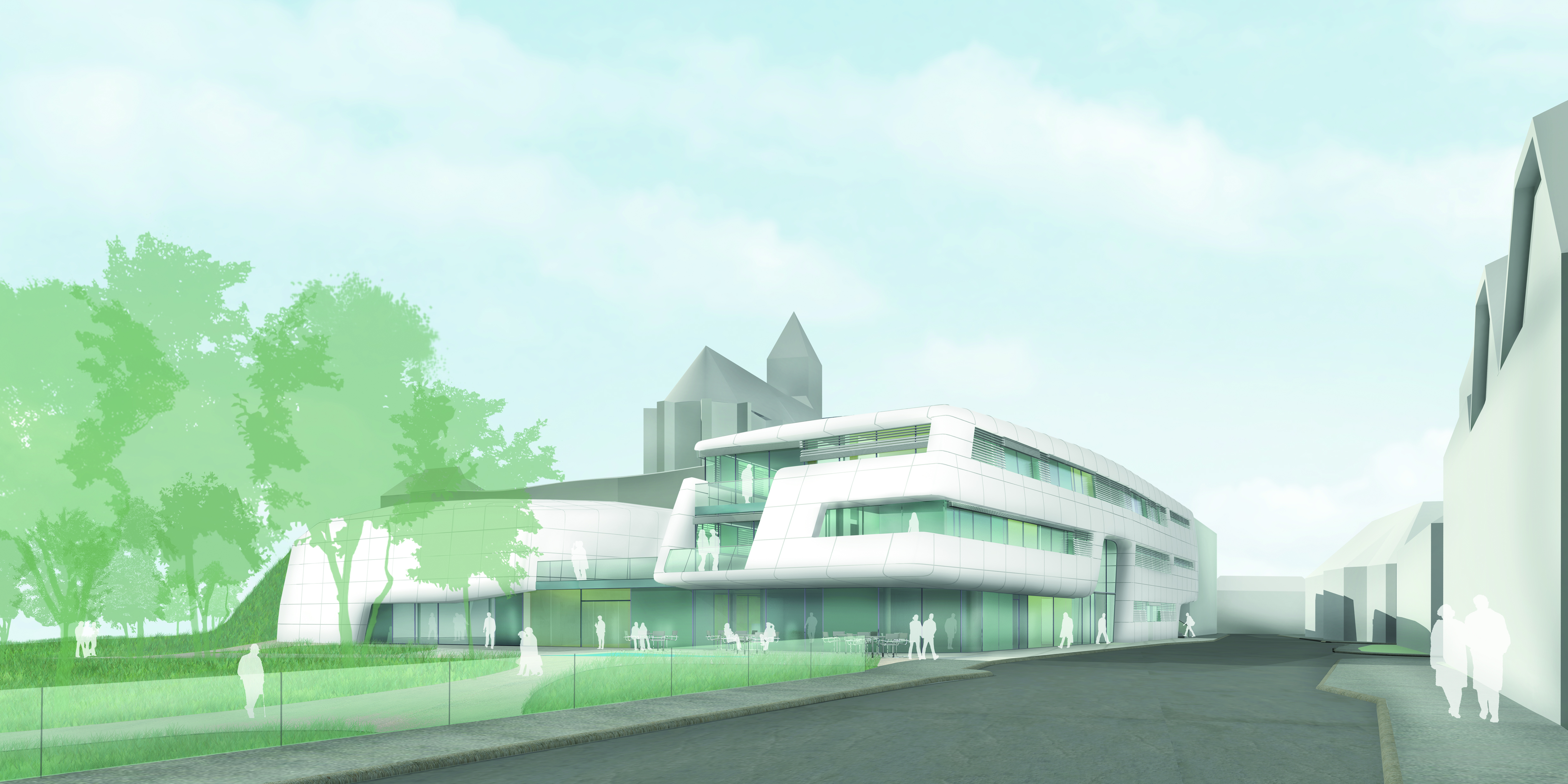
Location: Böheimkirchen (Lower Austria)
Year: Pan-European Competition 2012, 2nd Place
Use Area: ca. 3000m²
Team: Lukas Göbl, Oliver Ulrich
This design gives the educational full-day school concept an ideal form. The proposed spatial configuration promotes creativity and assists social processes, thus positively influencing the school climate. The addition is separated into two areas: The bridge, which adjoins the upper floor of the existing structure with a box, designed in two stories and positioned at the center of the school grounds. The third pillar is open space, placed around and even under the new building. An exterior staircase reorganizes the entrance area. A covered pathway leads beneath the bridge and, from here, into the school. The space beneath the bridge can be used in many different ways. Functionally, the bridge holds three full-day classrooms and the music room. All other spaces are situated in the box section: Foyer, restroom facilities, kitchen, storage space, library, cafeteria, chill-out area on the ground floor; teacher’s lounge, restrooms, and classrooms upstairs. The two building structures of the addition are designed very differently: The box is simple and sleek, while the bridge is characterized by strong accents of color. The new building can connect to the old one on the ground floor. Numerous multifunctional discovery areas are nestled like islands in the green space. Circular seating depressions make it possible to hold classes outside in the garden area. A central motion band and a lawn area animate children to play and run. A nearby “snack garden” with a watering point invites kids to play and discover the cycles of nature, here and in the biotope.
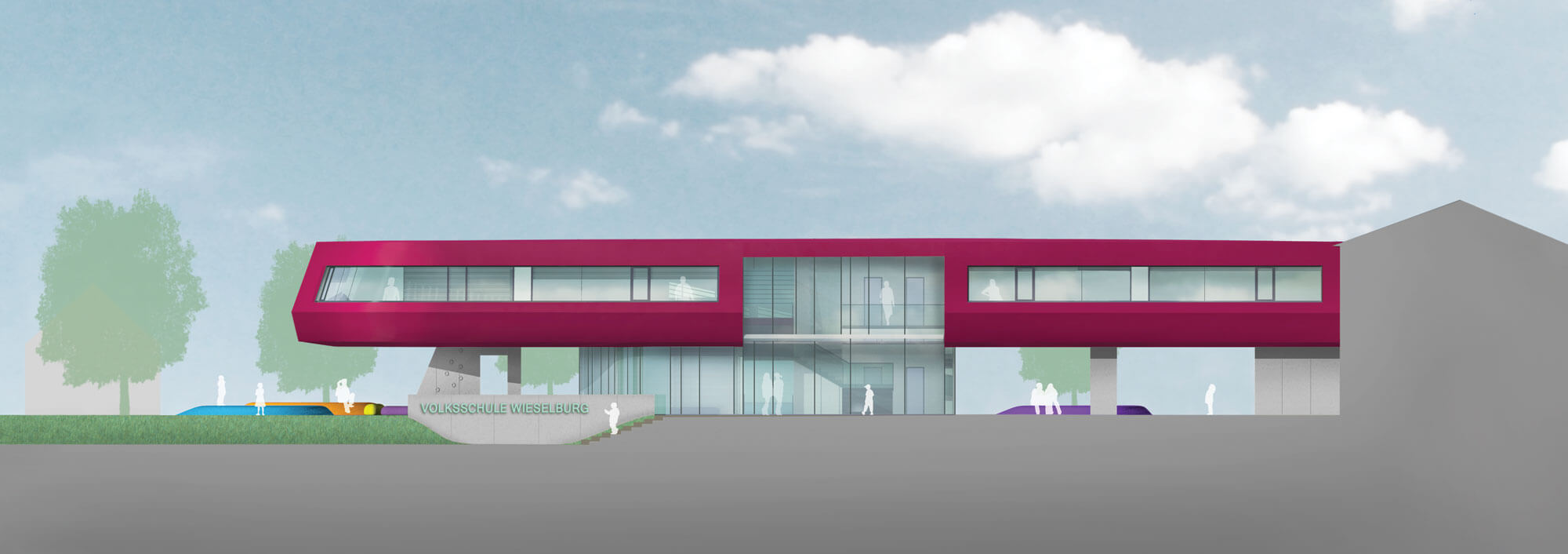
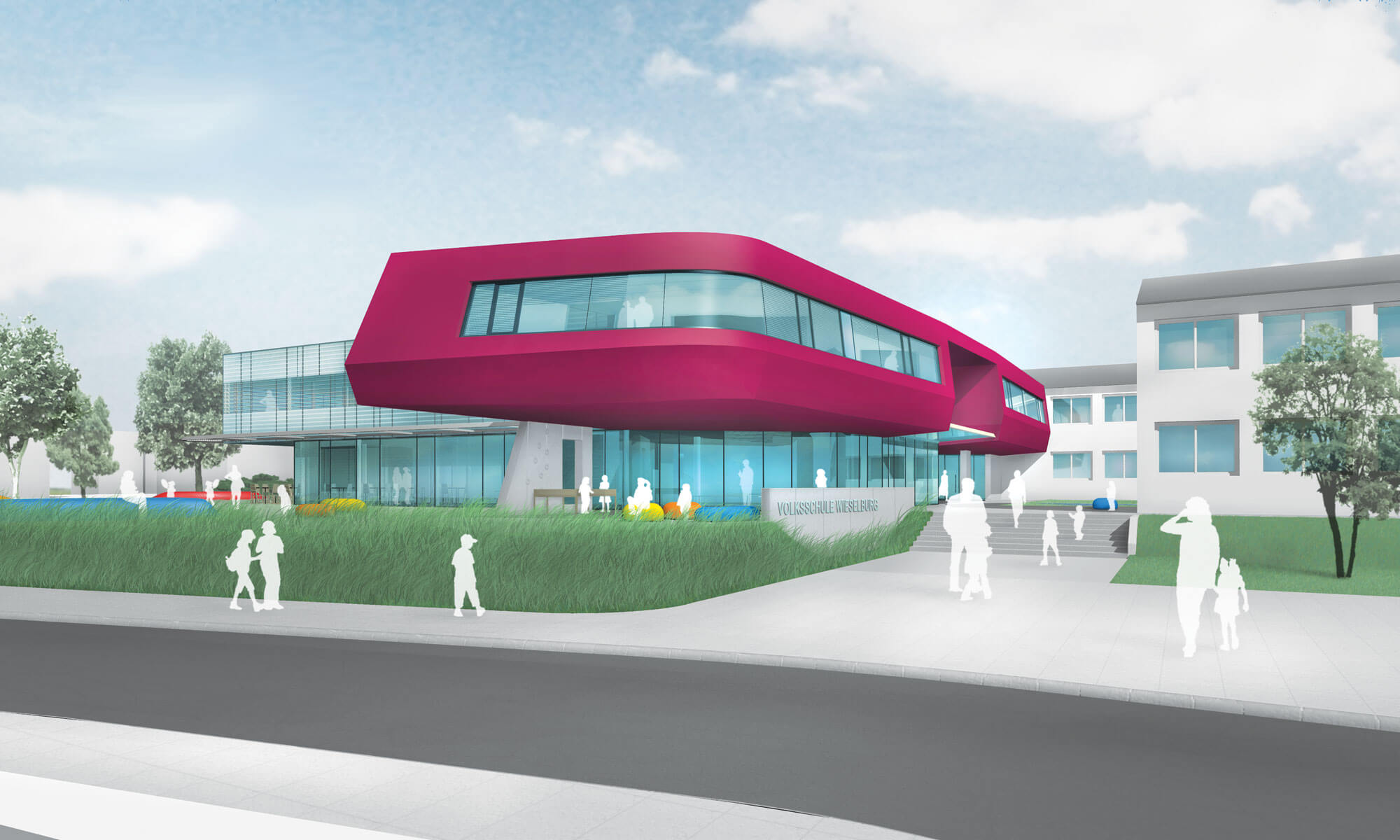
Location: Wieselburg (Lower Austria)
Year: invited competition 2012
Use Area: ca. 1000m²
Team: Lukas Göbl, Fritz Göbl, Oliver Ulrich
The Ötschertor Nature Campus ushers guests into a spectacular natural landscape upon their arrival. The traditional pre-Alpine building typology has fulfilled the needs of the people and utilized locally available materials since time immemorial. The region is characterized by the elements fire, water, wood, metal, and earth. The project is in the image of the surrounding landscape: Beautiful yet rough. By shifting the path of the existing entrance driveway and bridge, an ideal situation is created for the new building, the gateway to the nature park. A covered stairway and ramp structure leads arriving guests into the nature park center, ushering them onto a terrace. From here, they can enter the Welcome Center, the restaurant with a lakeside deck, the offices, and the multipurpose room. An atrium cuts into the building, opening, ventilating, and providing light for the entire interior of the structure. The wind turbine tower acts as a far-reaching visible symbol, an energy supply, and takes visitors to the walkable roofscape. The design also proposes a beach house with a boat dock and its own beach area. This ensemble can be reached directly from the parking lot and Welcome Center via a wooden walkway. The Ötscher Camp provides accommodations for up to 100 people in lodges, tents, and campers. The retention pool is also a pond for swimming. A centrally positioned sanitary building supplies the camp with places to cook, shower, and wash. There are numerous BBQ and fire pits on the grounds. The lodges hover over the campus grounds: Two modules provide the opportunity to stay either in simple lodgings or have the comfort of one’s own sanitary and kitchen facilities.
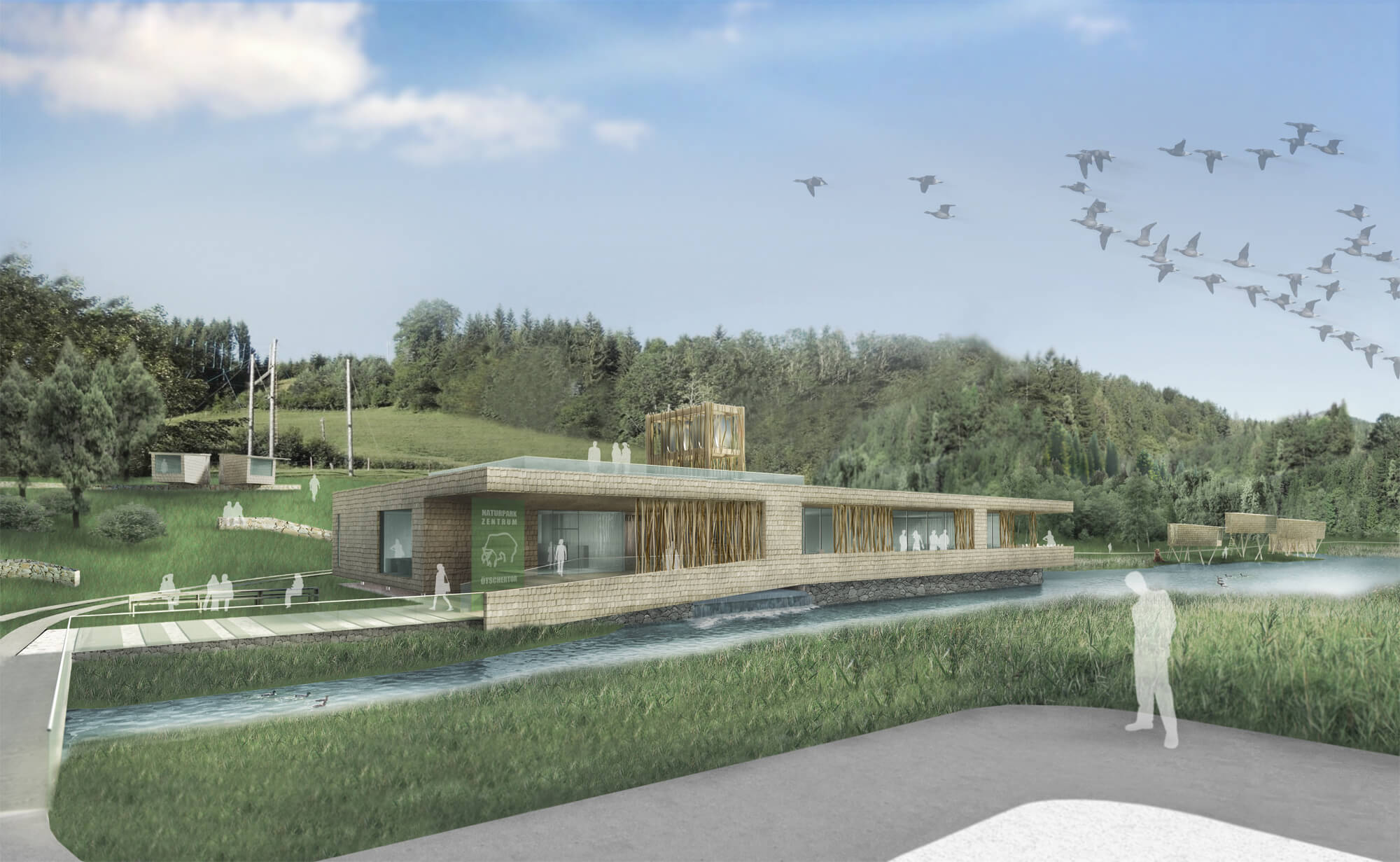
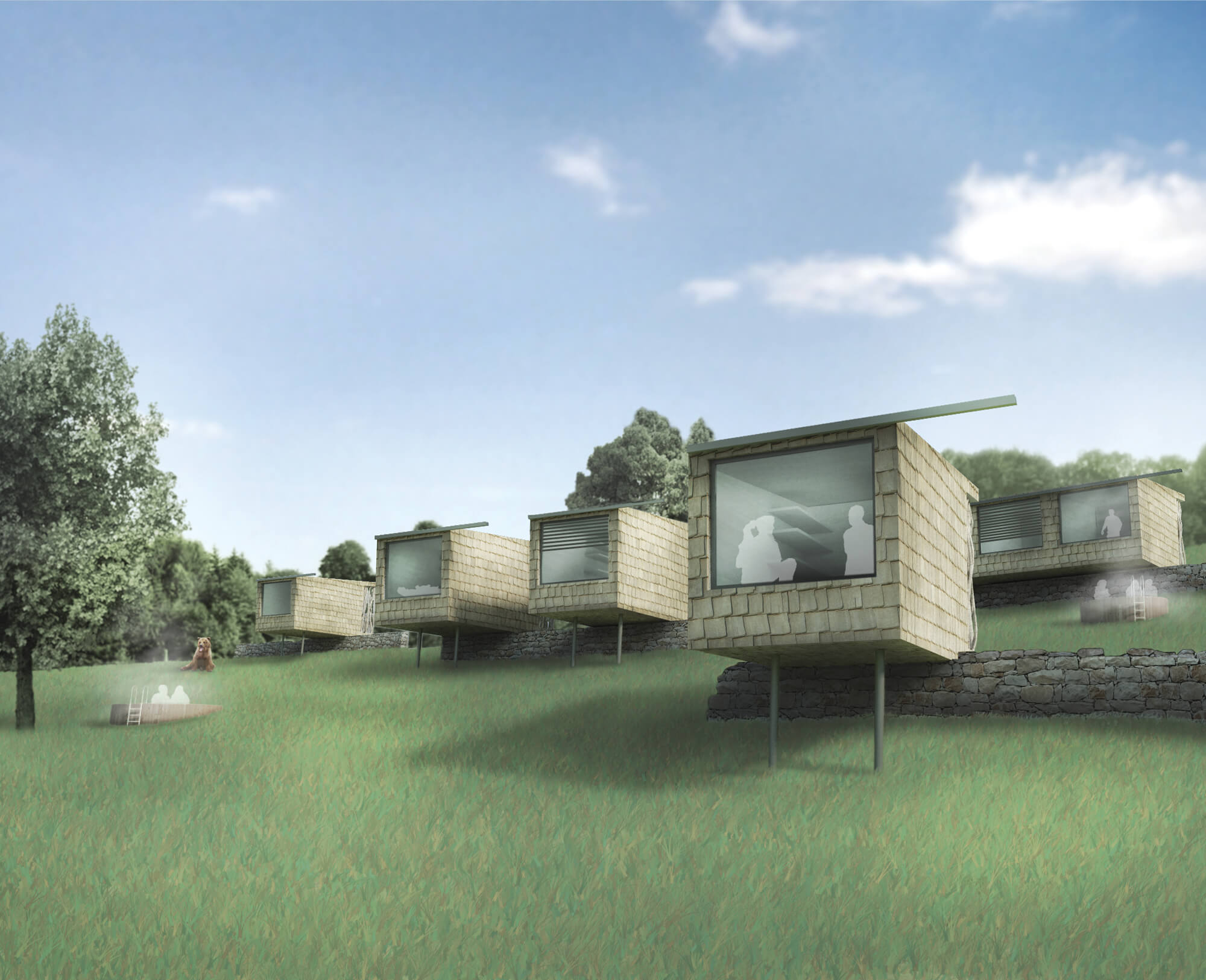
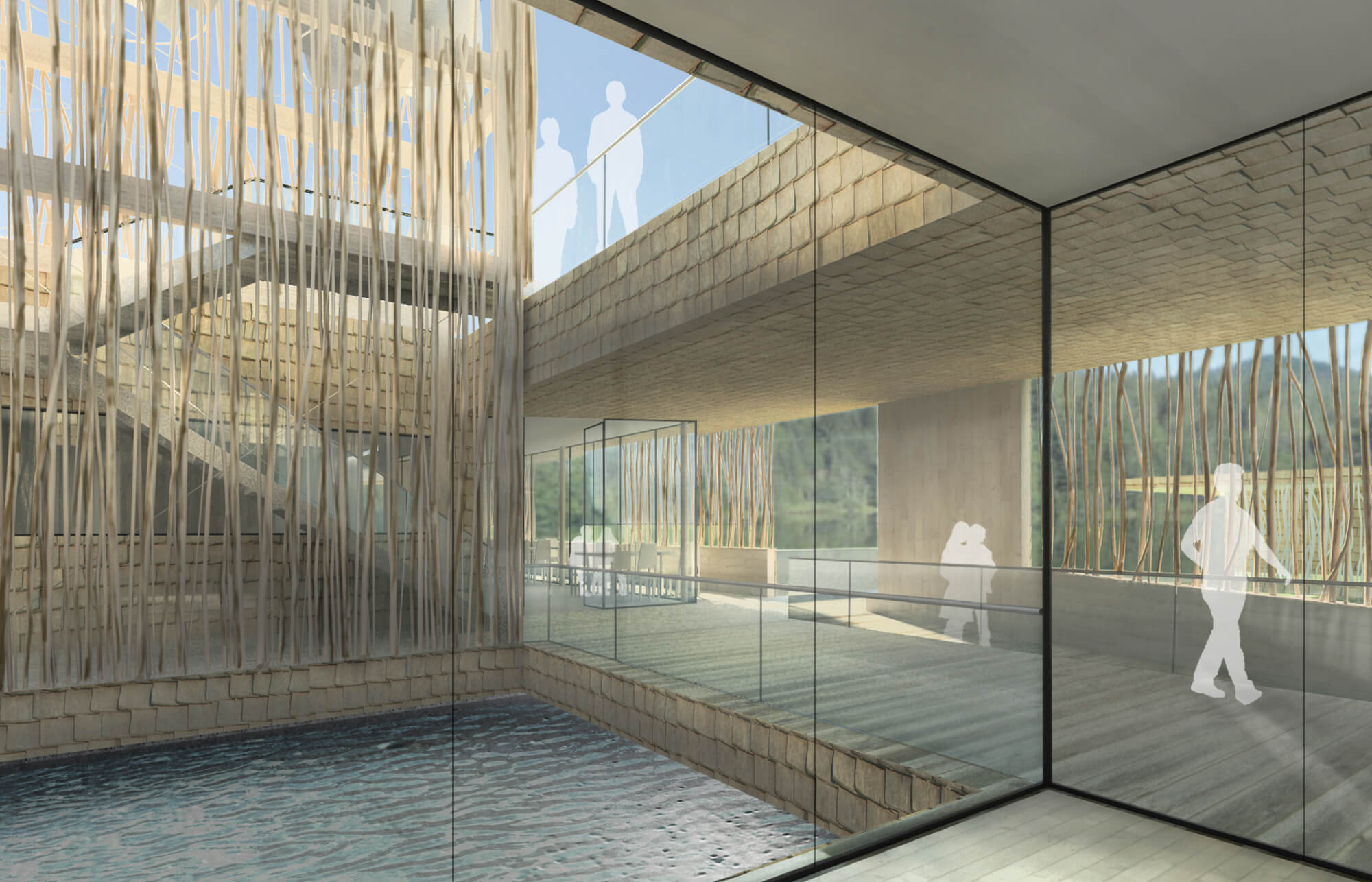
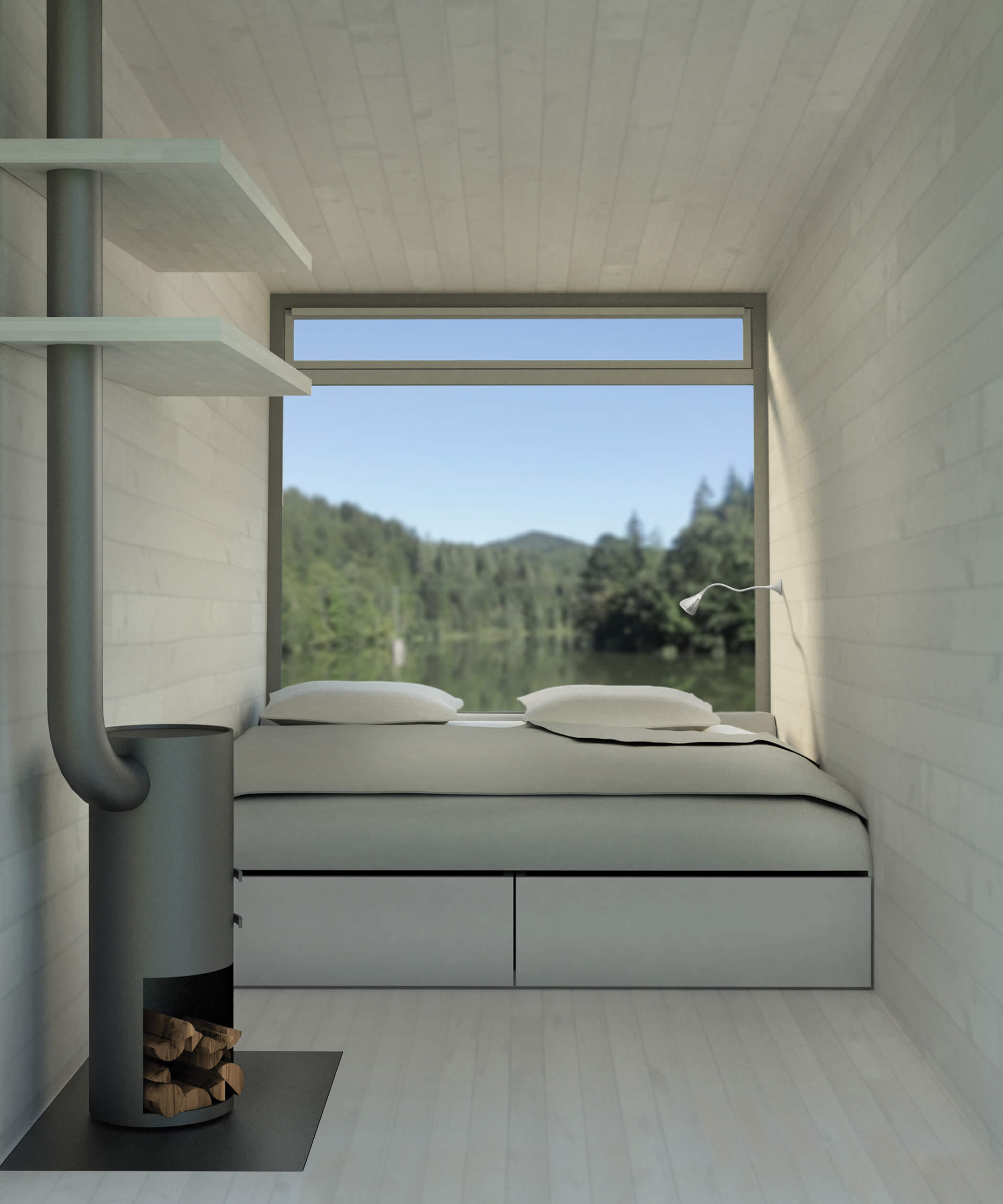
Location: Wienerbruck (Lower Austria)
Year: Competition 2013, 2nd Price
Use Area: ca. 1000 m²
Team: Lukas Göbl, Oliver Ulrich, Petra Gschanes
The new Lower Austria Gallery positions itself confidently, an identity creator and international pivot point of the Krems Art Mile. The corresponding building is a compact, spatially charming functional sculpture based on the fundamental principle of the White Cube. The desired urban situation is supported by the creation of a pedestrian zone with an outdoor dining area, water pools, green zones, and a centrally positioned main entrance. A walkway connects to the World Cultural Heritage Center, leading along the west façade of the museum onto the plaza in front of the Kunsthalle. The entrance and exit to the underground parking garage is located on Steiner Donaulände, between the gallery and the Caricature Museum. The 24-meter-high new building is designed to be both a solitaire and a connector between the existing cultural institutions and is surrounded by public space on all sides. This connects the Kunsthalle, the Caricature Museum, and the Lower Ausria Gallery, infusing the urban neighborhood with renewed energy. The flexible-use exhibition spaces in the new building are distributed across four levels and are 3.5 and 4.5 meters high, with the main room reaching a full 7 meters of height. An atrium expands the exhibition areas to the outside. The Kunsthalle and Caricature Museum are connected with the new Lower Austria Gallery on the 1st upper floor. This ensures simple orientation paths and activates synergies in the operation of the museums. Various visitor scenarios and tours can be offered. An event and catering area with a deck is located on the 4th upper story. The now larger restaurant on the ground floor of the Kunsthalle can be operated independently of museum opening hours.
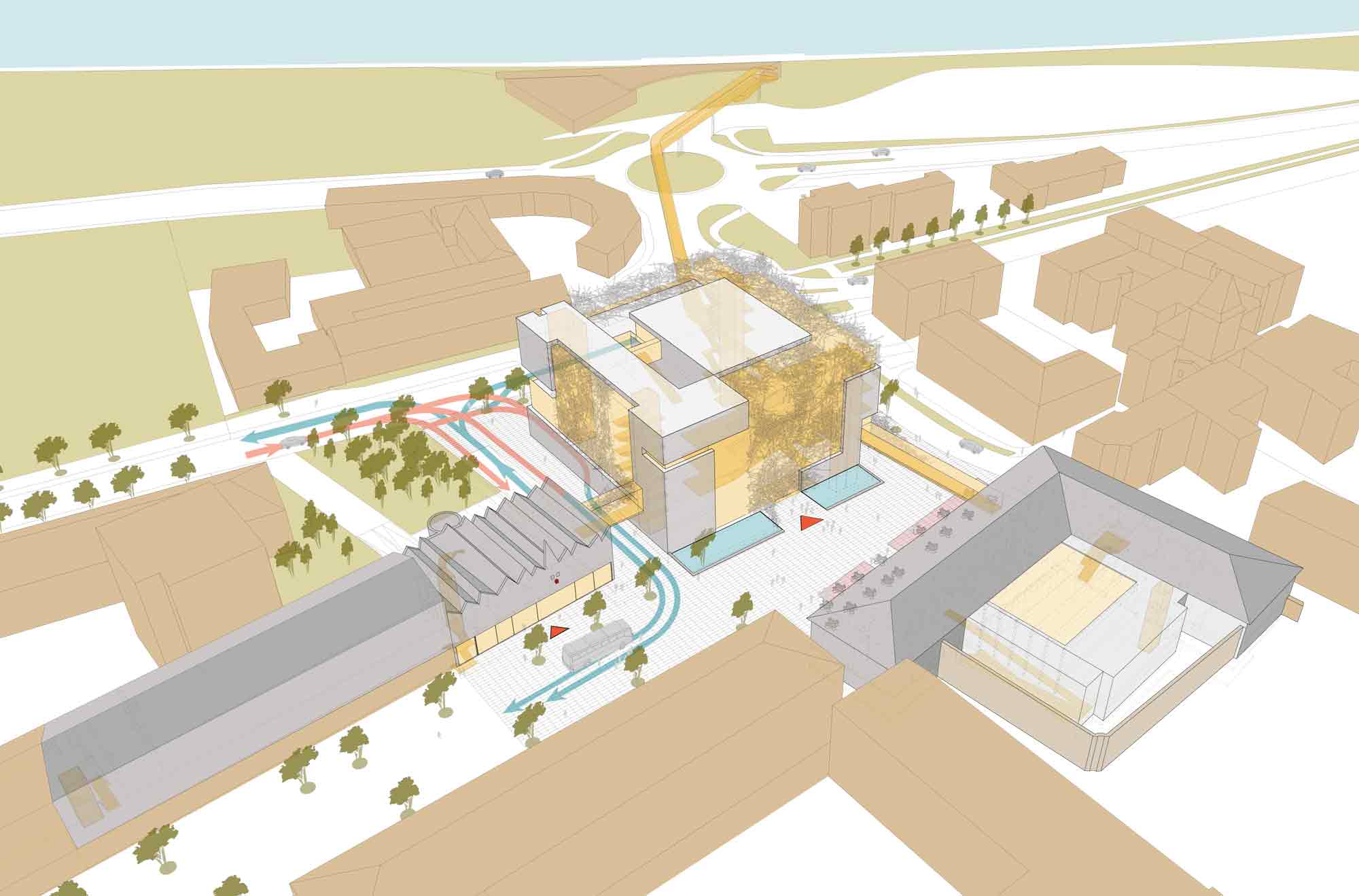
Location: Krems an der Donau (Lower-Austria)
Year: Competition 2015
Use Area: 10.000m²
Team: Lukas Göbl, Oliver Ulrich, Andrés España, Alexander Enz
Touch
Harvest or pick the plants and products of the pavilion
Process
Process harvested or picked products
Taste
Eat, drink, and enjoy the products made
Discover
Watch and observe, be inquisitive, examine, question, and discuss
Learn
Playfully learn about scientific topics on nutrition and energy
The Austria Pavilion will be inserted into the available volume of 83 x 15 x 12 meters. The building unites country and city, nature and technology, landscape and building — it sets the stage for Austria’s presentation at the EXPO 2015, a stage defined by Austria’s specialties, beauty, and innovation in alternative ways of living and eating. The Austrian pavilion will be constructed largely of native spruce timber. Wood grows quickly and is thus a viably sustainable building material that also has a long history in Austrian building traditions. Parts of the pavilion are used for various green spaces. Austrian companies have already developed innovative and tested stabilization and irrigation systems for green façades. The suspended façade is not only a clear eye-catcher, it also generates energy. So-called Solar Ivy (in red and white, the national colors), hangs from a steel grid and produces electricity. The wind tulip, an Upper Austrian product, noiselessly produces clean electricity.
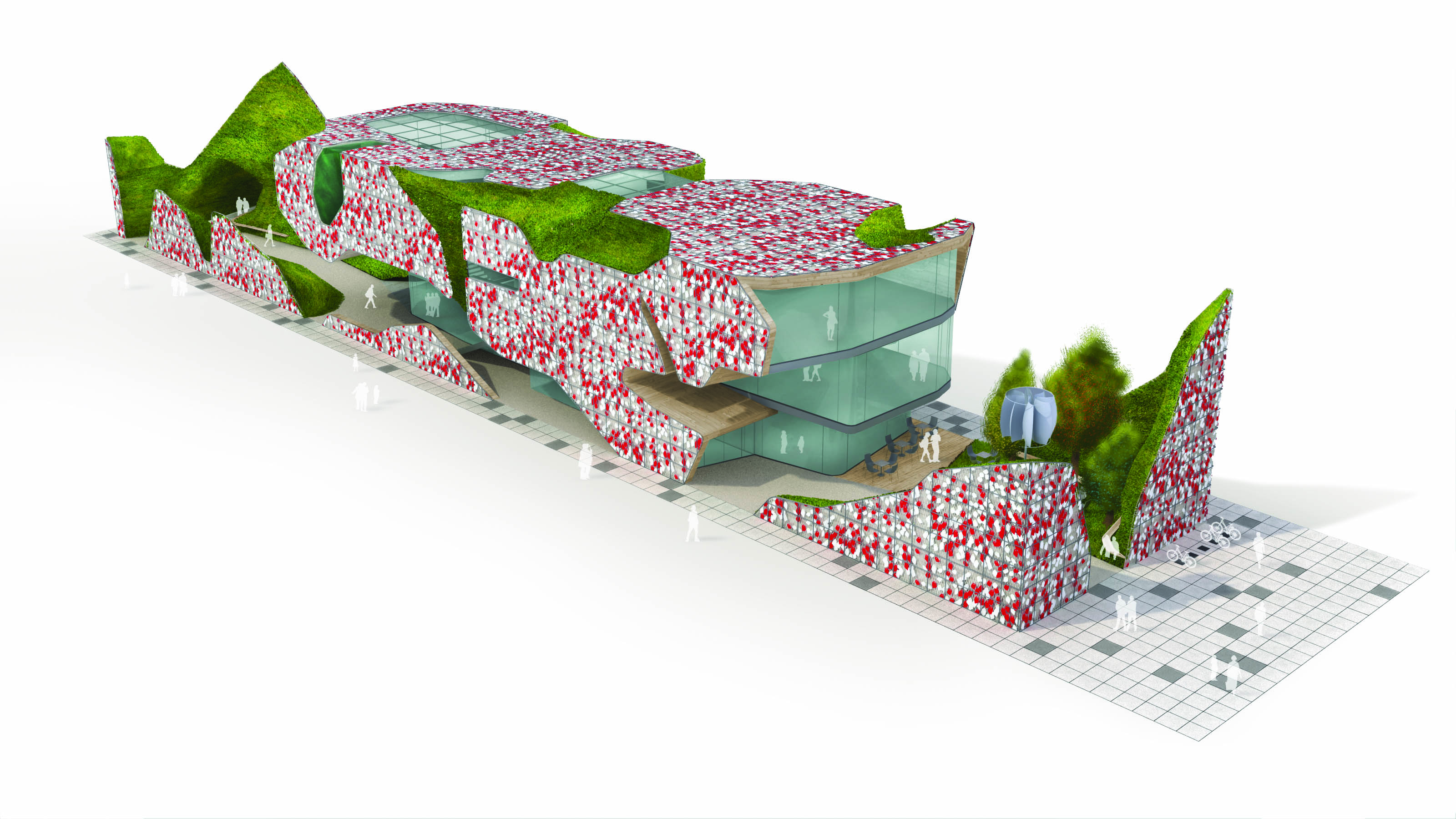
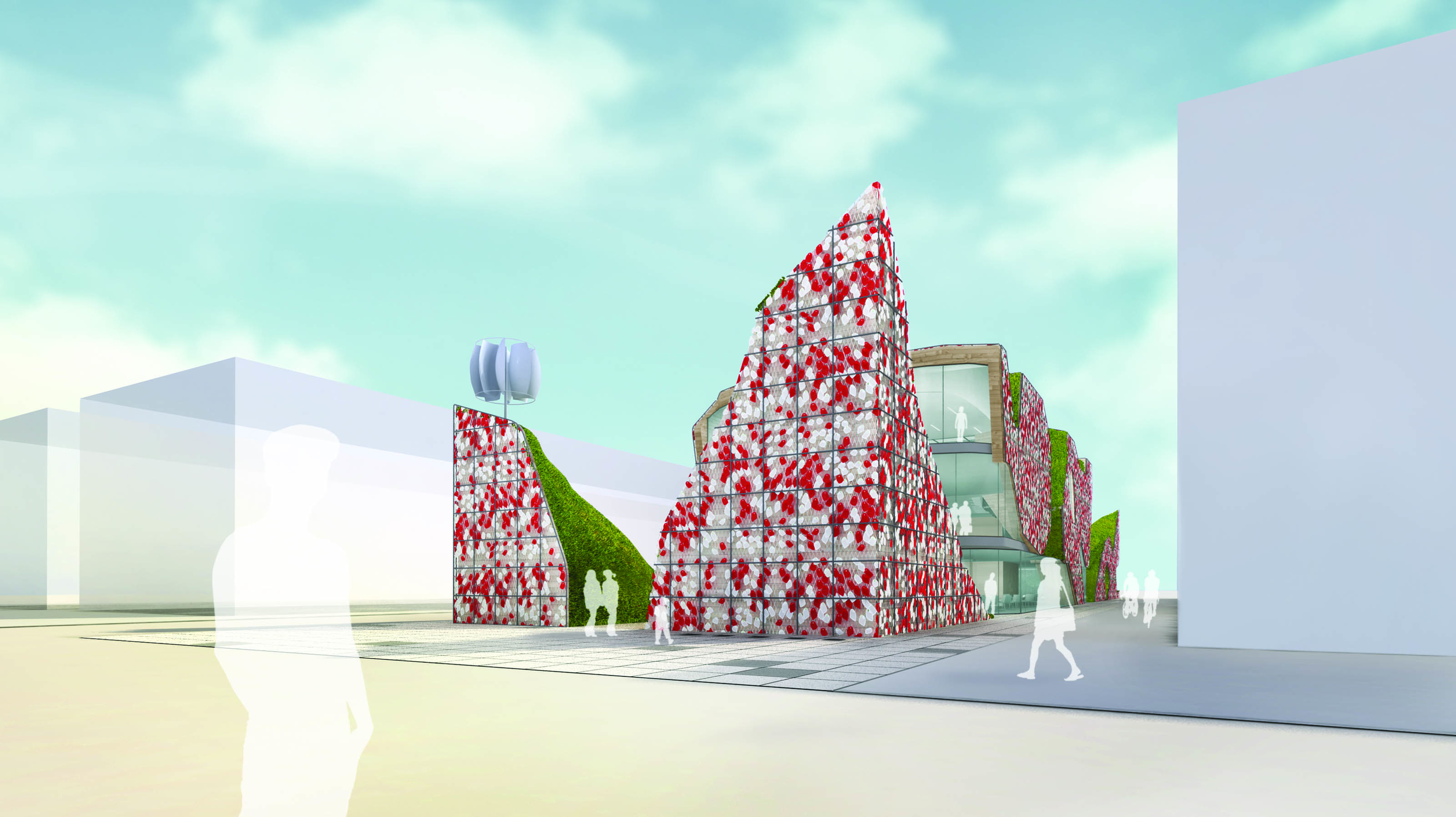
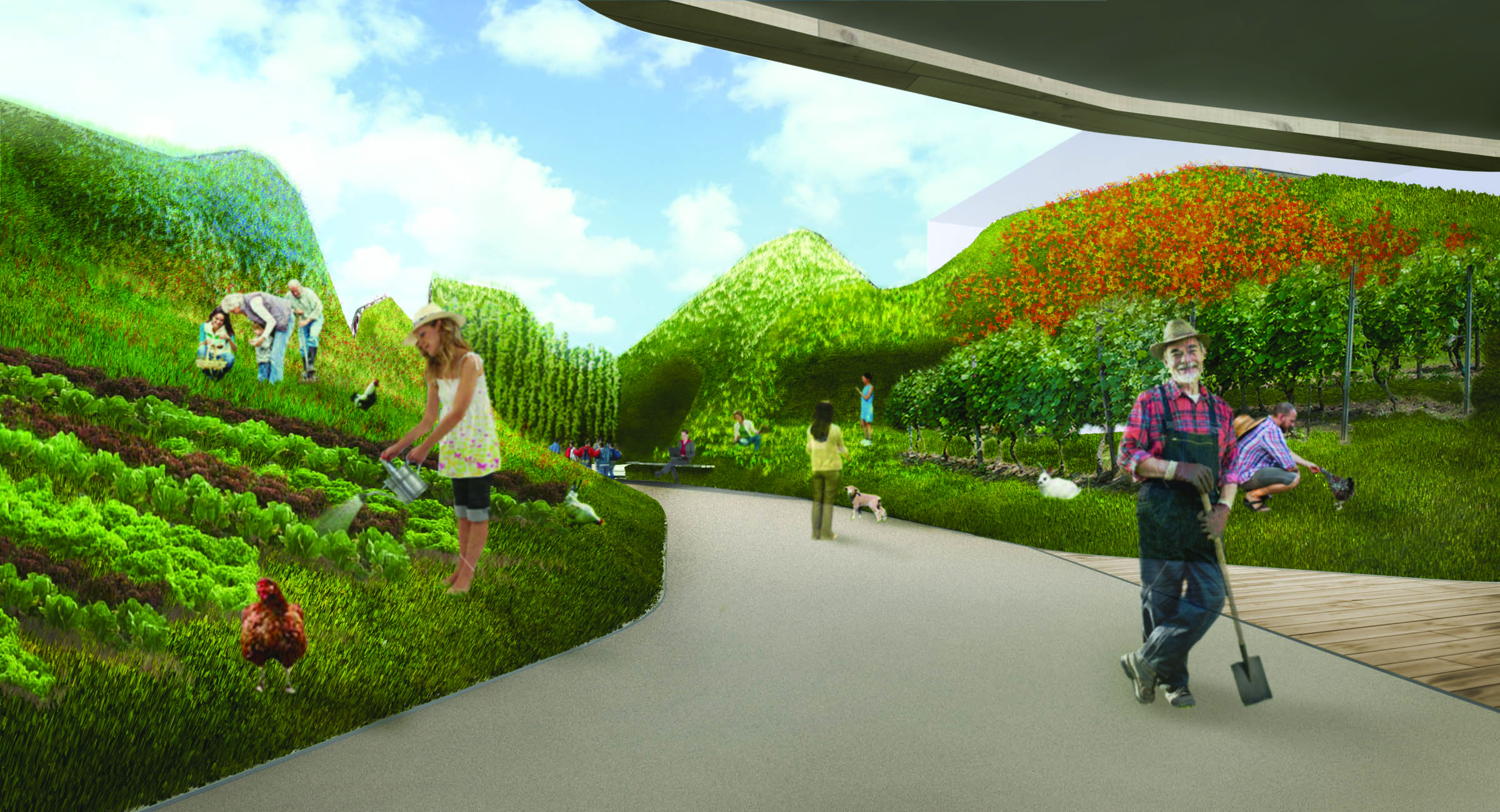
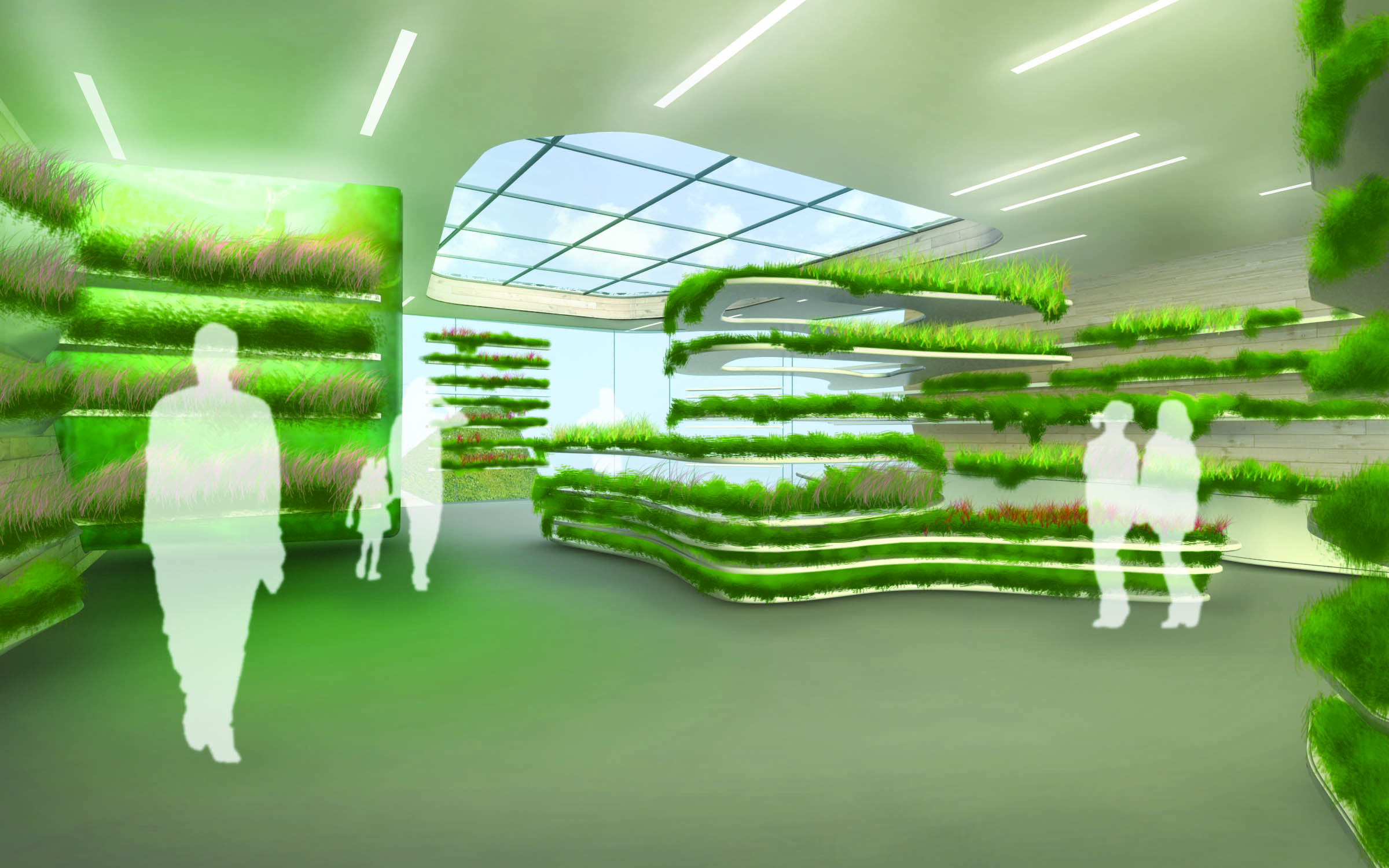
Location: Milan (Italy)
Year: Competition 2013
Use Area: ca. 1000 m²
Team: Lukas Göbl, Oliver Ulrich, Alexander Enz, Roxana Clep, Boris Steiner

























